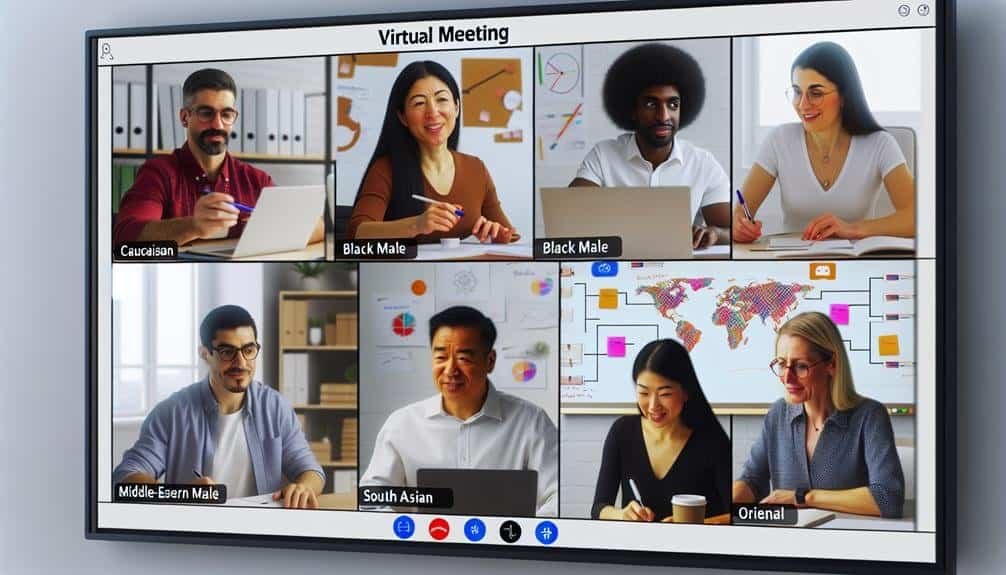Advanced Strategies for Effective Virtual Collaboration
In our increasingly digital world, the ability to effectively collaborate virtually has become paramount for many organizations. As technology continues to advance, so do the strategies and tools available for virtual collaboration.
From leveraging advanced communication platforms to navigating cultural and language differences, there are numerous factors to consider when striving for effective virtual collaboration.
In this discussion, we will explore some advanced strategies that can significantly enhance virtual collaboration, ultimately leading to improved productivity and teamwork.
Key Takeaways
- Utilizing advanced communication tools such as video conferencing platforms and interactive tools enhances virtual collaboration.
- Establishing clear virtual workflows with task assignments, instructions, and deadlines ensures effective collaboration.
- Streamlined communication channels using project management platforms and instant messaging tools facilitate seamless information flow.
- Defined decision-making processes involving input from all team members promote clarity and efficiency in virtual collaboration.
Leveraging Advanced Communication Tools
Leveraging advanced communication tools is essential for facilitating seamless virtual collaboration in today's professional landscape. In order to maximize engagement and encourage virtual brainstorming, it is crucial to employ effective communication strategies and interactive tools.
Utilizing video conferencing platforms such as Zoom or Microsoft Teams can enhance the virtual collaboration experience by allowing participants to engage in face-to-face discussions, share screens, and collaborate in real time. Additionally, leveraging interactive tools like virtual whiteboards and project management software enables teams to brainstorm, plan, and execute projects efficiently in a virtual environment.
Moreover, integrating instant messaging and chat applications such as Slack or Microsoft Teams can foster constant communication and idea sharing among team members, replicating the spontaneous interactions that occur in physical office settings. These tools facilitate quick exchanges of thoughts and ideas, leading to more productive virtual collaboration.
Furthermore, utilizing file-sharing platforms like Google Drive or Dropbox allows for seamless sharing and editing of documents, ensuring that all team members have access to the necessary resources for effective collaboration. By leveraging these advanced communication tools, organizations can overcome the challenges of virtual collaboration and achieve successful outcomes.
Establishing Clear Virtual Workflows
Effective virtual workflows rely on clear task assignments, streamlined communication channels, and well-defined decision-making processes. These elements are crucial for ensuring that team members understand their responsibilities, can easily collaborate with one another, and know how to escalate issues or make decisions when necessary.
Clear Task Assignments
Establishing a coherent and transparent virtual workflow is essential for effectively assigning tasks in a virtual collaboration setting. Effective delegation and task clarity are fundamental in ensuring that team members understand their roles and responsibilities.
When assigning tasks in a virtual environment, it's crucial to provide clear instructions, including the scope of the task, expected outcomes, and deadlines. Utilizing project management tools, such as task boards or shared documents, can help in clearly outlining task assignments and tracking progress.
Additionally, regular check-ins and status updates can ensure that everyone is aligned and on track with their assigned tasks. By establishing clear task assignments within a virtual workflow, teams can enhance productivity, accountability, and overall project success.
Streamlined Communication Channels
In a virtual collaboration setting, ensuring clear communication channels is pivotal for establishing a coherent and transparent workflow. Effective collaboration relies heavily on streamlined communication channels to facilitate virtual teamwork.
By implementing tools such as project management platforms, instant messaging, and video conferencing, teams can ensure that information flows seamlessly. Establishing clear protocols for communication, including designated channels for different types of discussions, helps eliminate confusion and ensures that all team members are on the same page.
Additionally, utilizing shared documents and cloud-based storage systems allows for easy access to relevant materials, further enhancing the efficiency of virtual collaboration. Regular check-ins and updates through these communication channels also play a crucial role in keeping everyone informed and aligned, ultimately contributing to the success of virtual teamwork.
Defined Decision-Making Processes
Ensuring streamlined communication channels in virtual collaboration sets the foundation for establishing defined decision-making processes, ultimately contributing to the clarity and efficiency of virtual workflows.
Consensus decision-making plays a pivotal role in defined decision processes within virtual teams. It involves gathering input and feedback from all team members to reach an agreement that aligns with the team's goals. This method ensures that everyone's perspective is considered, fostering a sense of inclusion and commitment to the final decision.
Additionally, efficient problem-solving techniques are crucial for maintaining effective virtual workflows. These techniques involve clearly defining the problem, analyzing potential solutions, and selecting the best course of action collaboratively.
Cultivating Trust and Accountability
In virtual collaboration, cultivating trust and accountability is crucial for effective teamwork.
Trust forms the foundation of successful collaboration, enabling team members to rely on each other and work together harmoniously.
Similarly, fostering an accountability culture ensures that each team member takes responsibility for their actions and contributes to the collective success of the team.
Trust in Teamwork
Cultivating trust and fostering accountability within a team is essential for achieving optimal virtual collaboration. To establish and maintain these crucial elements, team members should focus on:
- Building Rapport: Regular virtual team-building activities, informal check-ins, and creating opportunities for personal interactions can help team members build rapport and develop a deeper understanding of each other's strengths and working styles.
- Effective Delegation: Clearly defining roles, responsibilities, and expectations, and ensuring that team members have the necessary resources and support to fulfill their delegated tasks is vital for promoting accountability and trust within the team.
- Transparent Communication: Encouraging open and honest communication, providing constructive feedback, and actively listening to team members' concerns can help foster a culture of trust and accountability, leading to more effective virtual collaboration.
Accountability Culture
Fostering an environment of mutual trust and accountability is paramount for the success of virtual collaboration. This requires deliberate efforts to establish clear expectations and promote open communication among team members.
In a virtual setting, team accountability and individual responsibility are essential components of an accountability culture. Team accountability involves collective ownership of tasks and outcomes. Each member is responsible for their contributions and the overall success of the team.
Individual responsibility, on the other hand, emphasizes personal ownership and commitment to fulfilling assigned duties and meeting deadlines.
To cultivate an accountability culture, team leaders should set clear goals, define roles and responsibilities, and encourage open dialogue about progress and challenges.
Implementing Agile Project Management
Implementing Agile project management requires a shift in mindset and a commitment to embrace flexibility, collaboration, and iterative development processes. In the virtual workplace, agile adaptation is crucial to ensure virtual efficiency and project success.
Here are three key strategies for effectively implementing Agile project management in a virtual collaboration setting:
- Clear Communication: Implementing Agile project management virtually necessitates clear and transparent communication channels. Utilizing communication tools such as video conferencing, instant messaging, and project management software can facilitate real-time discussions, feedback, and updates.
- Adaptable Planning: Virtual teams must be able to adapt to changes swiftly. Agile project management encourages adaptable planning, allowing teams to respond to evolving requirements and market dynamics efficiently. This approach enables teams to prioritize tasks effectively and adjust project scopes as needed.
- Continuous Feedback Loops: Establishing continuous feedback loops is fundamental in Agile project management. Virtual teams can leverage feedback mechanisms to continuously improve processes, address challenges, and enhance collaboration, ultimately driving project success in the virtual environment.
Navigating Cultural and Language Differences
When working in a virtual collaboration setting, effective navigation of cultural and language differences is essential for fostering inclusive and productive teamwork. Cultural sensitivity and language barriers can significantly impact the success of virtual collaborations. To ensure effective communication and understanding among team members from diverse cultural backgrounds, it is important to prioritize cultural sensitivity and address language barriers proactively.
| Cultural Sensitivity | Language Barriers |
|---|---|
| Respect cultural norms and practices | Use clear and simple language |
| Be open-minded and inclusive | Provide language resources and tools |
| Seek to understand cultural differences | Encourage language learning and skill development |
| Avoid making assumptions based on stereotypes | Offer translation and interpretation support |
Enhancing Virtual Team Engagement
Effective virtual team engagement is crucial for achieving optimal collaboration and productivity in remote work environments. To enhance virtual team engagement, organizations can implement the following strategies:
- Virtual Team Building: Organize virtual team-building activities such as online games, virtual coffee breaks, or team challenges to foster a sense of unity and camaraderie among remote team members. These activities can help build trust, improve communication, and create a more cohesive virtual team.
- Remote Team Engagement Platforms: Utilize digital collaboration tools and platforms that facilitate virtual interaction, such as video conferencing, instant messaging, and project management software. These tools enable seamless communication, file sharing, and real-time collaboration, enhancing the overall engagement of remote teams.
- Regular Check-ins and Feedback Sessions: Schedule regular virtual check-in meetings and feedback sessions to ensure that team members feel connected and supported. Providing a platform for open communication and feedback can boost morale, address any challenges, and reinforce a sense of belonging within the virtual team.
Overcoming Time Zone Challenges
To effectively navigate the complexities of global virtual collaboration, addressing time zone challenges becomes a critical consideration in ensuring seamless communication and coordination among remote team members.
Effective scheduling is essential to overcome time zone differences. It is crucial to establish regular meeting times that accommodate all team members, taking into account their respective time zones. Utilizing scheduling tools that automatically adjust meeting times based on participants' time zones can streamline this process.
Moreover, it's important to foster cross-cultural communication to bridge time zone gaps. Team members should be encouraged to openly discuss their cultural norms and working hours, allowing for better understanding and accommodation of each other's schedules.
Additionally, utilizing communication platforms with asynchronous capabilities can help mitigate time zone challenges by allowing team members to contribute and access information at their convenience.
Conclusion
In conclusion, advanced strategies for effective virtual collaboration can significantly improve team productivity and communication.
It's ironic that while virtual collaboration tools aim to bring people closer together, they often create new challenges and barriers to effective teamwork.
By leveraging advanced communication tools, establishing clear virtual workflows, cultivating trust and accountability, implementing agile project management, navigating cultural and language differences, enhancing virtual team engagement, and overcoming time zone challenges, teams can work together more effectively in the virtual world.







